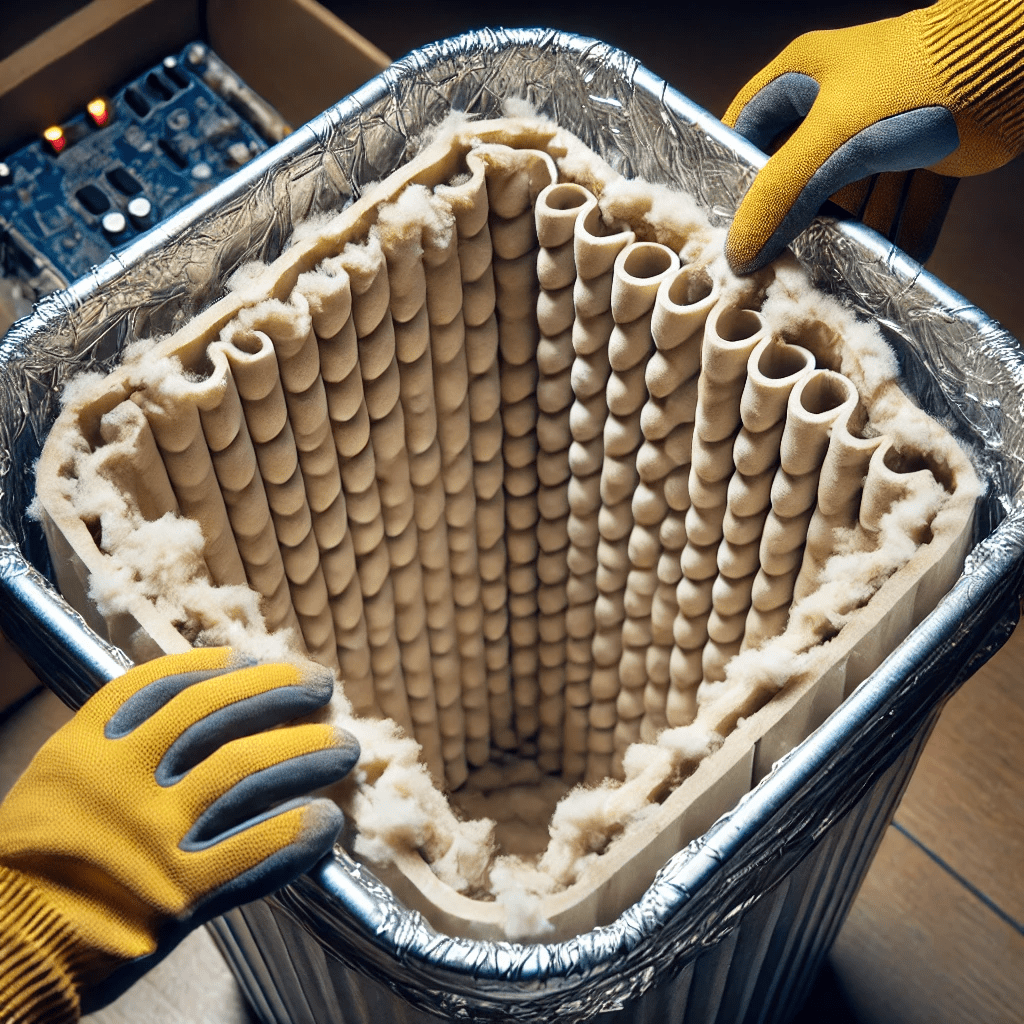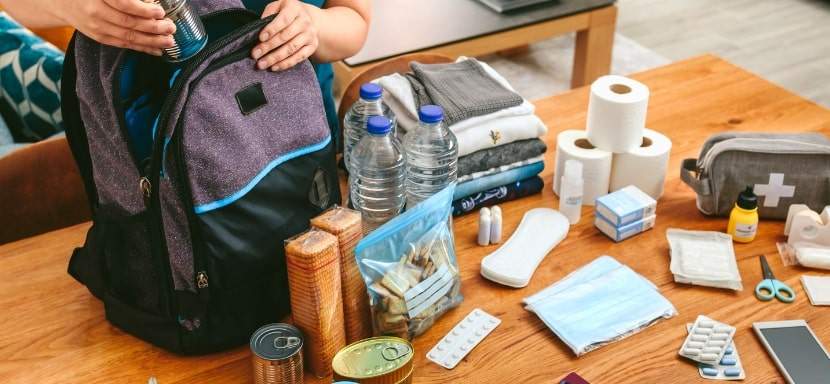How to Build a Faraday Cage

Have you ever had one of those moments when your phone seems to be on its own personal field trip through Wi-Fi signals, Bluetooth, and all kinds of electromagnetic noise?
Well, I have. The endless hum of invisible waves flying through the air makes you wonder—how can you block them out when you need a little peace or, better yet, protect your devices? Enter the Faraday cage. It’s surprisingly simple to build and trust me, if I can do it, you can too.
Key Points
- Material Selection: Choose metal containers and foil for effective shielding.
- Proper Assembly: Ensure a tight seal for maximum protection.
- Practical Applications: Use the cage to protect electronics from interference and EMPs.
What is a Faraday Cage?
A Faraday cage is an enclosure made of conductive materials, such as metal, to block external electromagnetic fields. Named after the scientist Michael Faraday, this structure works by redistributing electric charges around its exterior, effectively shielding anything inside from external electromagnetic interference (EMI). It acts like a protective bubble that prevents electric and magnetic signals from passing through. Whether a large container or a small wrapped object, the purpose remains to safeguard electronics or sensitive equipment from disruptive signals like Wi-Fi, radio waves, or lightning strikes.
Why Build a Faraday Cage?
Before diving into the nitty-gritty, let’s take a moment to answer the most pressing question: Why would anyone need a Faraday cage? Well, the reason is simple. A Faraday cage shields whatever is inside it from external electromagnetic fields. Whether it’s an intense lightning storm or someone with questionable intentions trying to scan your electronics, a Faraday cage protects you.
Electromagnetic Interference (EMI) is a big deal, especially when you’ve got sensitive electronics, medical devices, or even personal data to safeguard. With hacking on the rise, some people use it to protect credit cards or passports with RFID chips.
For the rest of us non-spies, it can keep your gadgets safe during a solar storm or, if you’re on the extreme end of things, an electromagnetic pulse (EMP). Not saying that’s bound to happen, but hey, better safe than sorry.
Materials You’ll Need to Build a Faraday Cage
Let me paint a simple picture: building a Faraday cage is more like wrapping leftovers than rocket science. You’ll need a few basic supplies and can even find them in your house. The key is to use conductive material, and trust me, you’ve got options. Here’s what you need:
Essential Supplies for a DIY Faraday Cage:
- A metal container or box can be as fancy as a steel trash can or as mundane as an old microwave. What matters is that it’s made of metal.
- Aluminum foil: The same stuff you use to wrap sandwiches will work.
- Insulating material: Anything non-conductive—plastic bags, cardboard, or bubble wrap will do the trick.
- Copper mesh or fine wire mesh (optional): For the overachievers.
- Tape or metal straps: To seal everything up tight.
You may also want to consider adding a grounded wire for extra safety, but it’s not essential unless you’re preparing for something major, like Armageddon or the apocalypse. (Just kidding…or am I?)
Did You Know?
Faraday cages aren’t just used for electronics—specific animal enclosures, especially for sensitive experiments, are designed like Faraday cages to block external electromagnetic noise. This helps researchers study animal behavior without interference from cell towers or radio signals!
Step-by-Step Guide: How to Make a Faraday Cage
Now that we have the materials let’s get our hands dirty. Well, maybe not messy, but we’ll cover them with foil.
Step 1: Select Your Container
The first thing to do is choose your container. A round or square metal trash can is popular because it’s cheap, and its lid provides an excellent seal. If you’re feeling frugal or minimalist, use an old shoebox wrapped in aluminum foil. The main idea is that the conductive material (the metal) surrounds your devices.

Step 2: Line the Interior with Insulation
No one wants their electronics fried by their own DIY project, right? So, line the inside of your container with an insulating material. You can use cardboard, plastic, or a Styrofoam insert to keep your devices from directly touching the metal. Insulation is essential because, without it, you’re turning your device into a cooked turkey on Thanksgiving.

Step 3: Wrap Your Devices in Aluminum Foil
Now, we’re getting to the fun part. Wrap each item you want to protect in at least two layers of aluminum foil. The foil should completely cover the object, with no gaps. The point is to ensure the metal can’t conduct any stray signals into your device. If it looks like you’re wrapping a potato for baking, you’re on the right track.
Step 4: Place the Devices Inside the Container
Once your gadgets are all foil-wrapped, place them inside the insulated container. Make sure they aren’t touching the metal on the outside. Again, this is where the insulation becomes your best friend. Double-check that everything is snugly packed.
Step 5: Seal the Container Tightly
Finally, it would be best to seal the container to ensure no signals sneak in. You can use metal tape or a heavy-duty strap for a metal trash can to keep the lid tightly closed. If you’re using a shoebox covered in foil, tape all the seams shut. You want no cracks where sneaky signals can slip through.

Testing Your Faraday Cage: Did You Do It Right?
You might think, “Okay, I built the thing—how do I know it works?” Good question. The simplest test is to put your phone or radio inside, seal it up, and then try calling or tuning in. If it doesn’t work or the radio can’t get a signal, congratulations—you’ve created your very own Faraday cage.
However, remember that this isn’t foolproof for all signals. Depending on the material and the strength of the signal, some may still get through. If you’re particularly concerned about EMPs or other large-scale events, you might want to upgrade to a more professional build.
Everyday Uses of a Faraday Cage
It’s not every day we worry about electromagnetic pulses wiping out our electronics (well, at least not most of us). But there are more practical, everyday uses for your homemade Faraday cage.
- Protect Your Devices During a Thunderstorm: Unplugging electronics is good, but storing them in a Faraday cage can give you extra peace of mind.
- Stop Car Key Hackers: Hackers can intercept signals from your car’s key fob. Wrapping it in foil or putting it in a Faraday cage prevents those signals from leaking out.
- Keep RFID Scanners at Bay: RFID scanners are used to read your credit cards or passports. A Faraday cage (even a simple wallet with metal lining) can protect you from unwanted scans.
Faraday Cage Maintenance Tips
While a Faraday cage doesn’t require much in the way of maintenance, there are a few things you should keep in mind to make sure it continues to work:
- Check for Gaps: Seals can weaken over time, and gaps may form. Periodically inspect your cage to ensure there are no openings.
- Replace Worn-Out Materials: Using tape or other fasteners may degrade. Replace them to keep your cage effective.
- Keep it Dry: Moisture seeping into the cage can cause corrosion. Keep your cage in a dry place.
FAQs
What materials are best for building a Faraday cage?
Any metal container works, but aluminum foil and wire mesh are good options.
Can I use a microwave as a Faraday cage?
Yes, an old microwave can work as a Faraday cage, as it’s already designed to keep electromagnetic waves from escaping.
Do I need to wrap my electronics in foil?
Wrapping your devices in foil adds an extra layer of protection from electromagnetic interference.
Will a Faraday cage protect my electronics from an EMP?
A well-constructed Faraday cage offers some protection against an EMP, but nothing is 100% foolproof.
How can I test if my Faraday cage is working?
Place a phone inside and try calling it. If it doesn’t ring, your Faraday cage is working.
Can a Faraday cage block all signals?
While it can block most electromagnetic signals, some strong or specific frequencies may still get through.
Final Thoughts on How to Make a Faraday Cage
Building a Faraday cage isn’t rocket science. In fact, with just a few household items, you can put together something that will help protect your electronics from electromagnetic interference. Whether for peace of mind during a thunderstorm or protection against the more unlikely EMP, a Faraday cage is an excellent tool in your arsenal. Why not give it a try? You’ll feel like you’ve outsmarted the electromagnetic world—and maybe you have.
Fascinating Facts About Faraday Cages
Faraday cages are more than scientific curiosities—they have practical uses that extend to everyday life. Below are a few interesting facts that highlight their importance and versatility.
-
Invented by Michael Faraday: The concept dates back to 1836 when the scientist demonstrated how a conductive enclosure could block electric fields.
-
Used in Modern Technology: Faraday cages protect sensitive electronics from electromagnetic interference in hospitals, laboratories, and airplanes.
-
Simple Working Principle: The cage redistributes electrical charges over its conductive surface, preventing external electromagnetic fields from reaching the interior.
-
Commonly Used in Microwaves: The metal mesh inside the door of your microwave acts as a Faraday cage, keeping harmful microwaves contained.
-
DIY-Friendly: You can create a Faraday cage with everyday materials like aluminum foil and metal containers, making it a practical solution for protecting electronics.
-
EMP Shielding: A properly constructed Faraday cage can safeguard your devices from damage in the event of an electromagnetic pulse (EMP).
More Survival Tips and Advice

How to Protect Yourself From Insects in the Wild
There’s nothing like being out in the wild—birdsong echoing through the trees, the fresh scent of earth, and a deep sense of peace that makes you think, “Ah, this is what life is about.” But then comes the buzzing. Mosquitoes, ticks, and flies swoop in like uninvited...

How to Identify Poisonous Plants
Exploring the great outdoors can be incredibly refreshing, offering a chance to reconnect with nature and unwind from daily stresses. However, it also comes with its fair share of risks. Chief among them? Poisonous plants. These hidden hazards can turn a peaceful...

How to Use the Sun to Tell Time
Using the sun to tell time sounds like a Robinson Crusoe novel. Imagine being stranded on a desert island with no phone, clock, or sundial. You'd still have one incredibly reliable resource: the sun. It’s been doing its thing for billions of years, and by the looks of...

How to Purify Water Using Boiling
When you're miles away from civilization, lost in the wilderness, or don't trust what's coming out of your tap, the idea of pure, clean drinking water starts to sound like a mythical oasis. Maybe it's all those survival shows you've binged, but suddenly, you're eyeing...

How to Make a Torch for Light
Creating your torch for light is not only a practical skill but also a rewarding craft. Whether preparing for a camping trip, looking for a unique DIY project, or wanting a reliable light source for emergencies, making a torch can be an enjoyable and valuable...
More Survival Scenarios

How to Survive a Layoff
When the Floor Falls Out: The Reality of a Layoff Layoffs feel personal—even when they're not. One day, you're responding to Slack messages and forwarding emails. Next, you're staring at your monitor as it logs you out... for good. Whether it's a restructuring, a...

How to Survive a Drug Test
The Cup, The Room, The Truth I never imagined I’d be so emotionally invested in a paper cup. But there I was, standing under the fluorescent hum of a strip-mall clinic, trying to recall the last time I ate a poppy seed bagel. That’s the thing about drug tests—they...

How to Survive an Interrogation
If you've ever been caught in the crosshairs of an overly enthusiastic mall cop or stared down by someone in a uniform with a clipboard and a glare, you’ve felt it — the chilly fingers of interrogation anxiety. And while most of us imagine interrogation scenes as...

How to Survive a Nightclub Shooting
Nightclubs pulse with life—lights flashing, music pounding, bodies packed tight on the dance floor. It’s a place to escape, feel the rhythm, and lose yourself in the crowd. But that same energy can turn deadly in seconds, transforming a night of fun into one of the...

How to Survive a Bachelor Party
A bachelor party is a delicate mix of celebration, chaos, and questionable decision-making, wrapped in the noble intention of sending the groom off into married life with a night he’ll (hopefully) remember. It’s a ritual as old as time—well, as old as men deciding...

How to Survive Your First Time at the Gym
Walking into a gym for the first time can feel like stepping into an alien world. The machines hum with purpose, the regulars move confidently, and you’re left standing there, clutching your water bottle, wondering whether you’re in the right place—or on the right...

How to Survive a Worldwide Communications Breakdown
Imagine waking up to silence. Your phone doesn’t buzz, your email won’t load, and even your local radio station crackles with static. A worldwide communications breakdown has hit. What next? For many, this doomsday scenario may sound like the opening lines of a...

How to Survive a Flash Flood While Driving
Surviving a flash flood while driving requires quick thinking, calmness, and a solid plan to ensure your safety. Preparation can make all the difference between a close call and a catastrophe in emergencies like this. This guide provides practical advice to protect...

How to Build an Emergency Kit
Emergencies don’t knock politely at the door. They barge in, uninvited, like a distant relative with a penchant for drama, turning your world upside down without warning. Whether it’s a power outage, a natural disaster, or an unexpected evacuation, the key to staying...

How to Protect Yourself From Insects in the Wild
There’s nothing like being out in the wild—birdsong echoing through the trees, the fresh scent of earth, and a deep sense of peace that makes you think, “Ah, this is what life is about.” But then comes the buzzing. Mosquitoes, ticks, and flies swoop in like uninvited...
